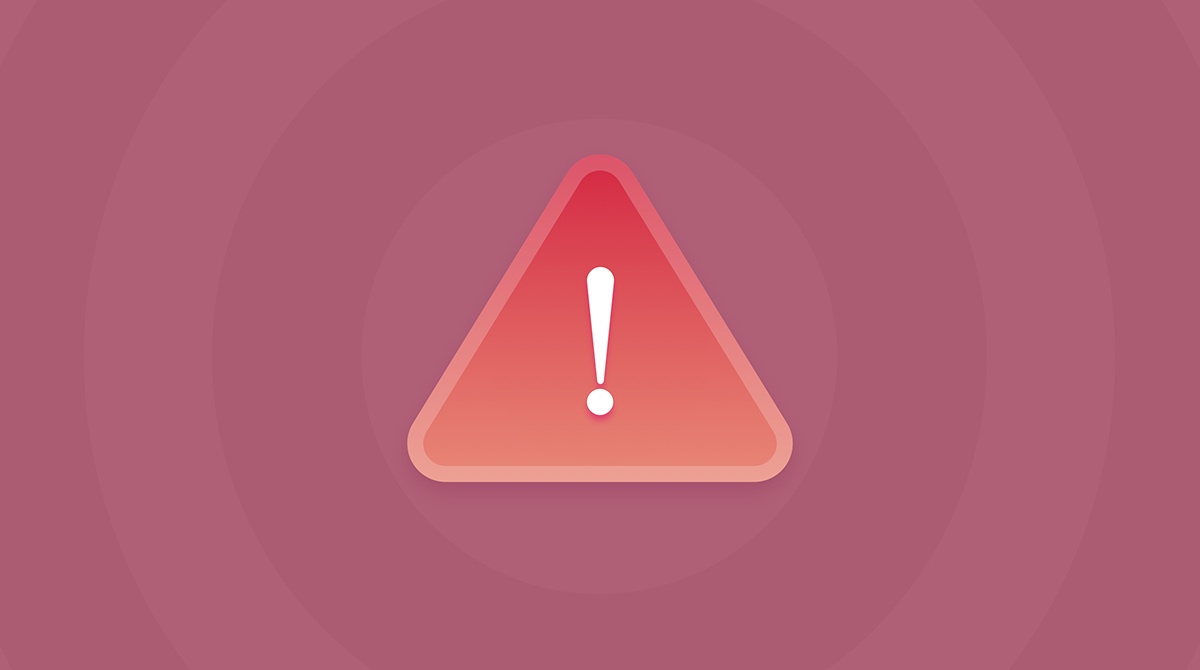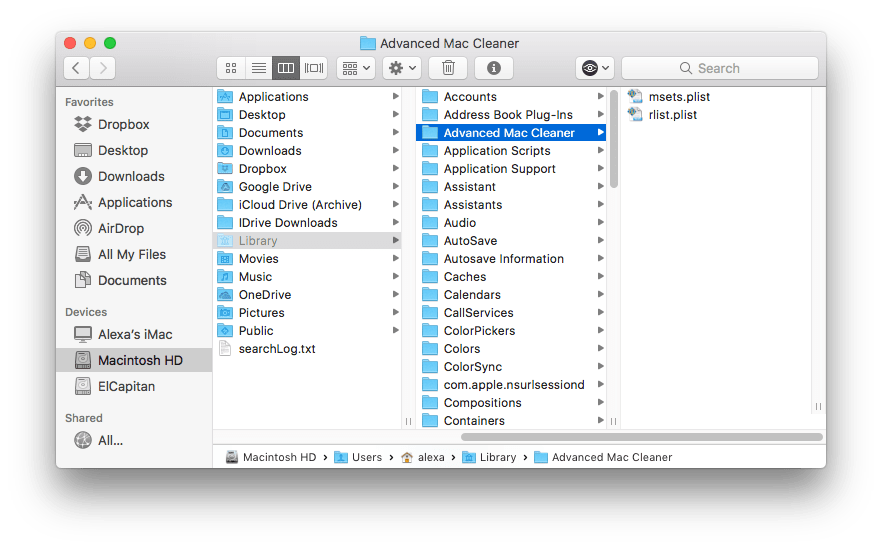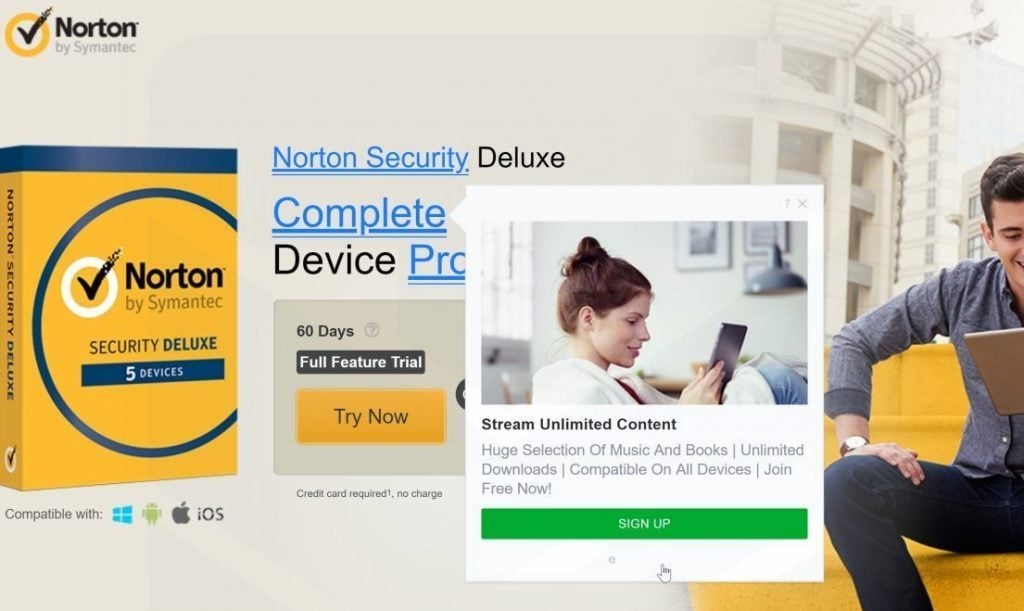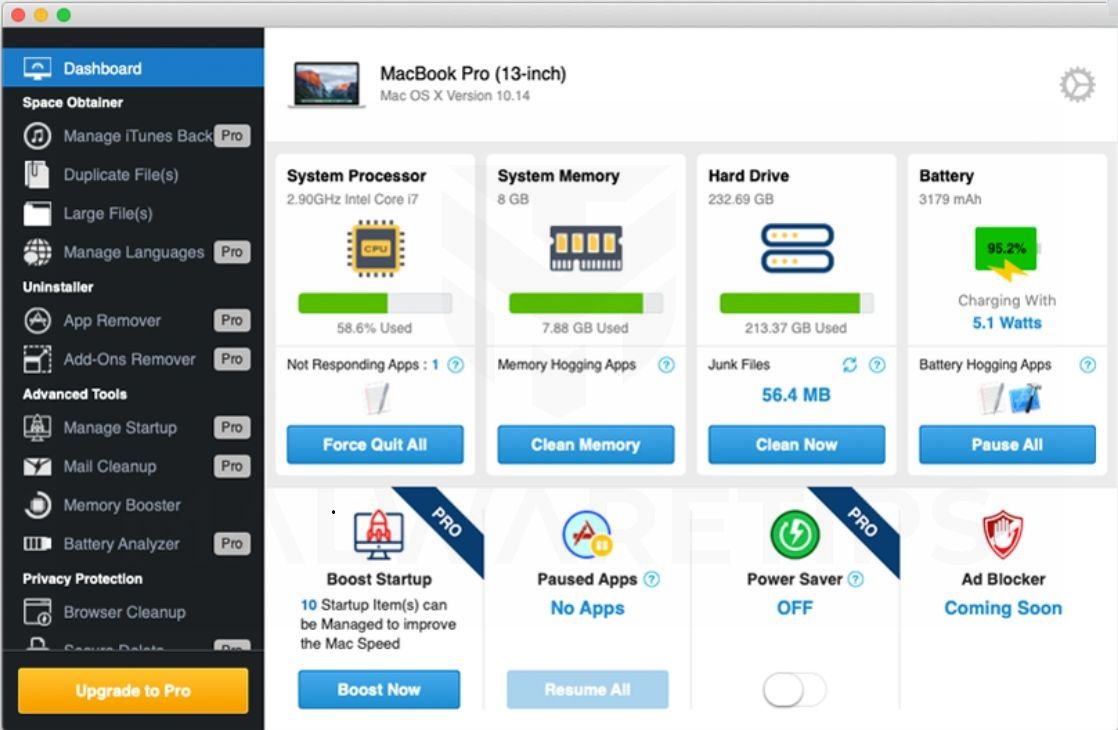Remove advaned mac cleaner potentially unwanted program related Mozilla Firefox add-ons: Open your Mozilla Firefox browser. At the top right corner of the screen, click the ' Open Menu ' (three horizontal lines) button. From the opened menu, choose ' Add-ons '. However, the easiest way to get rid of Mac Cleanup Pro (and other infections) is by using an anti-malware program. Combo Cleaner, Malwarebytes, and other good-quality anti-malware programs can detect and remove Mac Cleanup Pro and other malware with no problems. Unlike it, these programs are real security tools and not adware. App Cleaner & Uninstaller App Cleaner is a tool to delete apps on Mac completely and safely. Download Malwarebytes for Mac (the free version) and you get a 14-day trial of the premium version with automatic (real-time) virus and malware protection. After 14 days, your trial reverts to a limited disinfection scanner. Buy the premium version now to prevent infection in the first place. Professional Mac Antivirus (Premium) Combo Cleaner is equipped with award winning virus, malware, and adware scan engines. Free Antivirus scanner checks if your computer is infected. To remove infections, you will have to purchase the full version of Combo Cleaner.
Advanced Mac Cleaner is an unacceptable computer tool or program that every user wishes get rid from the Mac OS X system. It is deemed as invasive type of software that may be installed on the computer without user’s approval. This kind of malware is spreading on thousand of computers worldwide through Internet connection. Software exploits and vulnerabilities in Internet browser programs are believed to be exploited by Advanced Mac Cleaner to gain access on target computer. Malicious links from social media sites and spam email messages also contributes to the delivery of Advanced Mac Cleaner onto victim’s computer.

When this potentially unwanted program is run on the system, it can perform various actions to take control or certain system functions. Furthermore, Advanced Mac Cleaner does not provide entries to instantly remove its code when user is not comfortable with it. In addition, this unknown security and optimization tool may block your Internet access to security web sites preventing you from downloading removal tools and proper guide to delete Advanced Mac Cleaner from the affected computer.
Once Advanced Mac Cleaner is running on the computer, it will begin to display fake warnings and pop-up alerts stating several infections detected on OS X operating system. Obviously, these alerts are just ploy to deceive computer users and force them to pay for the Advanced Mac Cleaner registration code.
As you can see, Advanced Mac Cleaner program was made to steal money from you using various method of deception. Never pay for this worthless program and execute the removal steps to eliminate this threat from the computer right away.
Procedures to Remove Advanced Mac Cleaner
This section contains complete instructions to assist you in removing potentially unwanted program from Mac system.
Procedures published on this page are written in method that can be easily understand and execute by Mac users.
Quick Fix - Scan the System with Combo Cleaner
Combo Cleaner is a trusted Mac utility application with complete antivirus and optimization features. It is useful in dealing with adware and malware. Moreover, it can get rid of unwanted program like Advanced Mac Cleaner. You may need to purchase full version if you require to maximize its premium features.
1. Download the tool from the following page:
2. Double-click the downloaded file and proceed with the installation.
3. In the opened window, drag and drop the Combo Cleaner icon onto your Applications folder icon.
4. Open your Launchpad and click on the Combo Cleaner icon.
5. Wait until antivirus downloads its latest virus definition updates and click on 'Start Combo Scan' to start removing Advanced Mac Cleaner.
6. As shown in the image below, Combo Cleaner accurately detects Advanced Mac Cleaner rogue program. Proceed with the removal of the virus by upgrading Combo Cleaner to full version.
Free features of Combo Cleaner include Disk Cleaner, Big Files finder, Duplicate files finder, and Uninstaller. To use antivirus and privacy scanner, users have to upgrade to a premium version.
Proceed with the rest of the removal steps if you are comfortable in manually removing malicious objects associated with the threat.
Step 1 : Quit Advanced Mac Cleaner Process
Before proceeding with the steps below, please close Advanced Mac Cleaner window if in case it is open.

1. Go to Launchpad, Utilities folder, open Activity Monitor.
2. Choose All Processes from the upper right corner of the window.
3. Under Process Name column, look for Advanced Mac Cleaner. Click the name to select the malicious process.
4. Next, click the Quit Process button located in the upper left corner of the window.
5. When prompted, click on Force Quit.
6. You may now delete or remove files that belongs to Advanced Mac Cleaner. Proceed to the next steps.
Step 2 : Delete Advanced Mac Cleaner Login Items
Some malware also installs login item into compromised account under System Preferences. This object automatically runs Advanced Mac Cleaner during user log in.
1. Go to Apple menu and choose System Preferences.
2. Select Users & Groups from the preferences window.

3. You may need to Unlock this area in order to make changes. Click on the Lock icon on lower left corner of the window.
4. Next, select user account that runs Advanced Mac Cleaner.
5. Click on Login Items tab.
6. Select Advanced Mac Cleaner from listed entries and click on the minus [-] button and confirm your actions. Please see image below for reference.
As stated, the creation of Login Items or profile is case-to-case basis. Some unwanted application may add their entry on this section but others are not concern on making one. So, if Advanced Mac Cleaner Login item is not present, please continue with the succeeding steps.
Step 3 : Delete Advanced Mac Cleaner Application
1. Go to Finder.
2. On the menu, click Go and then, select Applications from the list to open Applications Folder.
3. Find Advanced Mac Cleaner or any unwanted program.
4. Drag the Advanced Mac Cleaner to Trash Bin to delete the application from Mac.
5. Right-click on Trash icon and click on Empty Trash.
Step 4 : Delete Malicious Files that have installed Advanced Mac Cleaner
1. Select and copy the string below to your Clipboard by pressing Command + C on your keyboard.
~/Library/LaunchAgents
2. Go to your Finder. From the menu bar please select Go > Go to Folder...
3. Press Command + V on your keyboard to paste the copied string. Press Return to go to the said folder.
4. You will now see a folder named LaunchAgents. Take note of the following files inside the folder:
- com.pcv.hlpramc.plist
- amc.plist
If you cannot find the specified file, please look for any unfamiliar or suspicious entries. It may be the one causing Advanced Mac Cleaner to be present on your Mac. Arranging all items to see the most latest ones may also help you identify recently installed unfamiliar files. Please press Option + Command + 4 on your keyboard to arrange the application list in chronological order.
5. Drag all suspicious files that you may find to Trash.
6. Repeat Step 2, numbers 1-5 procedures on the following folder (without ~):
/Library/LaunchAgents
7. Please restart the computer.
8. Open another folder using the same method as above. Copy and Paste the following string to easily locate the folder.
~/Library/Application Support

9. Look for suspicious objects or folders with the following names and drag them to the Trash.
- AdvancedMacCleaner
- AMC
10. Repeat procedures 8 and 9 on the following folders if necessary.
~/Library/Caches
11. Go to your Finder and open the Applications Folder. Look for subfolders with names similar above and drag them to Trash.
12. Lastly, please Empty your Mac's Trash bin.
Step 5 : Run another Scan using MBAM Tool for Mac
1. Download Malwarebytes Anti-malware for Mac from the link below.
2. Run Malwarebytes Anti-malware for Mac. It will check for updates and download if most recent version is available. This is necessary in finding recent malware threats including Advanced Mac Cleaner.
3. If it prompts to close all running web browser, please do so. Thus, we advise you to PRINT this guide for your reference before going offline.
4. Once it opens the user interface, please click on Scan button to start scanning your Mac computer.
5. After the scan, Malwarebytes Anti-malware for Mac will display a list of identified threats, Advanced Mac Cleaner is surely part of it. Be sure to select all items in the list. Then, click Remove button to clean the computer.
6. You may now restart the computer.
Although 2020 will surely go down as “virus year,” viruses on Mac are not going anywhere. Just recently, a fake Adobe Flash Player updater named Shlayer has infected 10% of all Macs in the world (according to Kaspersky’s lab).
Even newer malware type, Tarmac, is increasingly sweeping the Mac world. All it takes to contract it is to open a pirated website or even click a link on Wikipedia. At least that’s been the case with Shlayer, which had its malicious links planted inside Wikipedia’s external resources.
In this Mac Malware removal guide, we’ll tell you how to get rid of malware on your Mac. We’ll also cover how to tell apart different viruses on Mac: adware, scareware, and others. We’ll be using the manual methods as well as some respected antivirus tools for Mac. Let’s go.
What is malware
First off, let’s point out that the term “malware” is a broad term for all unwanted intrusions. It’s also not synonymous with the term “virus” because the latter is only a model of distribution i.e. how an app self-replicates. Here are common types of malware you can encounter on Mac:
- Download managers — download unauthorized objects
- Spyware and keyloggers — steal users’ personal data
- Backdoor infections — apps that remotely seize control of your computer
- Rootkit — infiltrate admin privileges
- Botnet — turn your Mac into a shadow bot
- Trojan horses — apps disguised as legit software
- Ransomware — lock your Mac’s screen
- PUP — potentially unwanted programs
Among these, PUPs are the most numerous type. According to Malwarebytes, Windows platform is no longer a hotbed for viruses — the macOS is. The has been a 400% spike in macOS-specific malware infections with an average of 11 threats per number of Mac devices — the same figure for Windows is only 5.8.
Mac malware: The symptoms
Oftentimes a malware app would trick you into believing it’s perfectly harmless. Such apps are known to disguise themselves as antiviruses, extractors or video players. But how to check your Mac for viruses? Here are some of the tell-tale signs:
- A sudden drop in Mac’s performance or frequent freeze-ups.
- Pages that you visit get obscured with ads.
- Unexpected Mac reboots or apps starting for no reason.
- Your browser installs suspicious updates automatically.
How Mac can get infected with malware
By clicking on fake Flash Player updater. Or by installing a seemingly useful browser extension. As of 2020, a trojan browser extension NewTab infected 30 million Mac computers. This malware disguised itself as a parcel tracking helper but was in fact spreading ads. So how to protect your Mac from malware? You can start by studying typical infection gateways.
How to remove a virus from Mac
Just as with any disease, to doctor a virus you need to remove the infected part of your software — as simple as that.
1.Remove malware from Mac manually:
The Activity Monitor
If you know which app on your Mac is malicious, you’re half-way through the problem. First of all, you need to close the app and then root it out from the system processes.
- Open Activity Monitor (type its name in the Launchpad).
- Locate the problematic app in the Processes.
- Use [x] button to quit the process
Now go back to your Applications and move the app to the Trash bin. Immediately empty the Trash.
This method is simple, but for the best malware removal results, you’d have to invest a bit more time. There are still parts and pieces of the virus app scattered around your system folders. It’s a bit like killing a dragon that re-grows its head after you’ve chopped it off. To remove malware from your Mac completely, it’s better to use a powerful uninstaller.
Do a quick search for virus-infected .DMG files within your Downloads. The potential culprits could be recently downloaded files, especially media-related ones. Delete them and empty the Trash bin.
2. Get rid of malware using CleanMyMac X
CleanMyMac X has a 10-year reputation of guarding Macs around the world. The app will scan your Mac for any vulnerabilities and offer immediate removal if it finds something suspicious. CleanMyMac detects thousands of malware threats, including viruses, adware, spyware, ransomware, cryptocurrency miners, and more. The app’s database is regularly updated to keep all those “-wares” away from your Mac.
Here’s how to remove malware from your Mac:
- Download CleanMyMac X — it’s free to download.
- Click Malware Removal tab.
- Click Scan.
- Click Remove.
- Done!
3. Remove Mac malware from your Login Items
Most adware or spyware will try to sneak inside the bootup process. Good news, you don’t have to be Kaspersky to prevent this.
- Go to the Apple menu > System Preferences.
- Choose Users & Groups section.
- Make sure if your username is highlighted.
- Open Login Items tab.
Now use the “—” sign to disable all the suspicious apps (like Mac Defenders) that you’ll find. Restart your Mac for the changes to take place.
4. Get rid of pop-up ads on Mac
Advertising pop-ups are browser-related, so whatever browser you are using, be prepared for a thorough cleanup. First off, don’t buy into whatever the ad is telling you. Some scary alerts would mention 343 viruses found on your Mac forcing you to immediately install a “Mac Defender” or “Mac Security” tool. Just ignore it and don’t click anywhere on the pop-up. Use [x] button and if it doesn’t close the ad, Ctrl + click the browser icon to quit the browser completely.
Hold the Shift key when starting a new Safari session. This way all your previous tabs (including the ad pop-up) will not be reopened.
How to block pop-up ads in Safari
- Open Safari preferences (in the top menu).
- Go to the Security tab.
- Tick “Block pop-up windows”.
How to get rid of pop-ups in Chrome
- Open Chrome Settings (a three-dot icon)
- Click Privacy and security
- Go to Site settings > Pop-ups and redirects
- Locate the Popups tab and block them from appearing
Additionally, make sure your browser’s homepage is set to standard Google page or other trusted source.
5. Clean up extensions to remove adware from Mac
Apple lists several browser extensions as potentially malicious. The list includes:
- Amazon Shopping Assistant by Spigot Inc.
- Slick Savings by Spigot Inc.
- FlashMall
- Cinema-Plus
This is just to give you an idea of how different these adware extensions could be. But if you’re looking at how to remove malware from the Mac Safari browser, follow this path.

Remove extensions in Safari
- Go to Safari Preferences
- Choose the Extensions tab
- Select an extension and click Uninstall
Disable browser extensions in Chrome
And here’s how to remove malware from Mac Chrome. Open Chrome and click Window in the top menu. In the bottom of the list choose Extensions. This opens up the list of all your installed extensions. Now use a trash bin icon to remove the ones you suspect are adware viruses. Right after that, your Chrome experience should get much less distracting.
Just to be doubly sure, we recommend you to remove all the extensions you'll find. Later you can re-install each one separately.
TIP: How to remove Mac adware via Javascript
You can prevent some malware attacks from happening by disabling JavaScript in your browser. Although, it may break certain webpages, your browsing will get more secure and, likely, faster too.
To disable JavaScript in Safari
- Go to Safari Preferences > Security.
- Uncheck Enable JavaSript.
6. Launch Agents and Daemons: Where else to look
So far we’ve covered browser Extensions, Applications, and Login Items trying to remove malware from your Mac. But these are not the only locations where malicious agents may be hiding. Another type of system services that could be affected by malware are the so-called Launch Agents and Daemons — yes, the name does derive from the word demon. These are small helper programs that stealthily run in the background, like software updaters or automatic backups.
Mac Pro Cleaner Removal Products
While Launch Agents and Daemons are two different entities, both can be infiltrated by malware. As it often happens, trojan apps would place their executable files within the Launch Agents folder. The result — the virus app launches automatically and potentially harms or steals your data.
7.How to remove daemons and agents from Mac startup
- Click Finder.
- Choose Go > Go to Folder.
- Type in:
/Library/LaunchDaemons
For Launch Agents, repeat the steps above, but this time search in 2 more locations:
/Library/LaunchAgents
~/Library/LaunchAgents
Inside you’ll find a bunch of PLIST files and if some of them look suspicious to you, delete them. Sure, the names of these files may not be very telling, but if you already know the problematic app that you are after, knowing this folder may help you fully extinguish it.
Don’t forget to reboot your Mac — until you do, all these files are still in memory.
One more way to remove daemons, agents, and plug-ins
If the manual path described here sounds too complicated, you can again be rescued by CleanMyMac X. This app has a special tool to remove malware Launch Agents.
- Download CleanMyMac X (it’s free to download).
- Install the app.
- Click Optimization tab > Launch Agents
- Click Perform.
By the way, this app has a real-time anti-malware monitor. It monitors for any problematic apps that try to get into your Launch Agents. If it finds such, it will notify you and offer to remove the intruder.
Mac Pro Cleanup Removal
If all else fails
Below a few more ideas to help you remove malware from Mac.
- Switch to a different user account and do a full system cleanup.
- Restore your Mac using Time Machine (to the point before it got infected).
- Update all your software, including the macOS.
How to protect Mac from malware
As a conclusion, we’ve prepared a few basic tips to minimize your chance of catching malware in 2020 and beyond. They are just as relatable for a PC computer.
Mac Cleaner Free
- Closely read those dialogue boxes
- Get a reliable password manager app
- Browse anonymously
- Cover your webcam when possible
- Use passphrases instead of passwords
- Create an “emergency” bootable SD card for your Mac
OK, looks we’ve covered how to remove malware from Mac including both manual and software solutions. Hope your Mac stays virus-free and may you never click on those scary Mac alerts again.